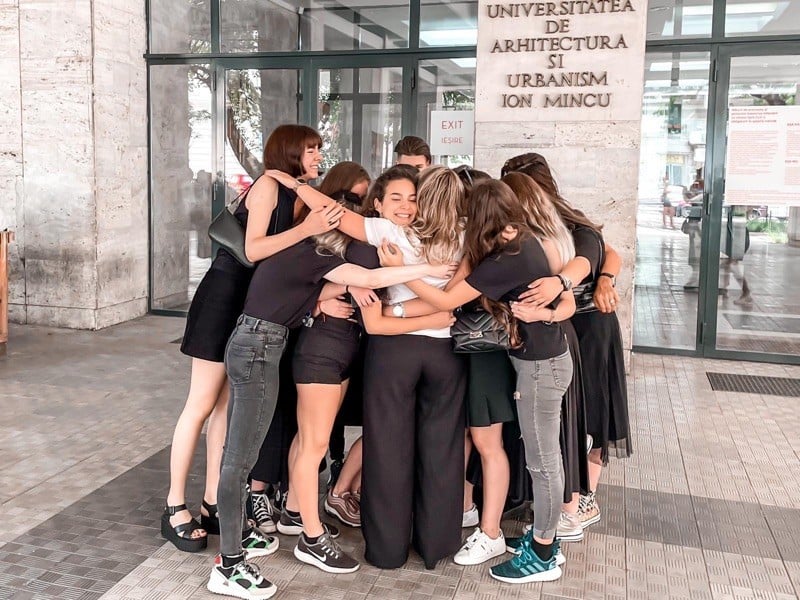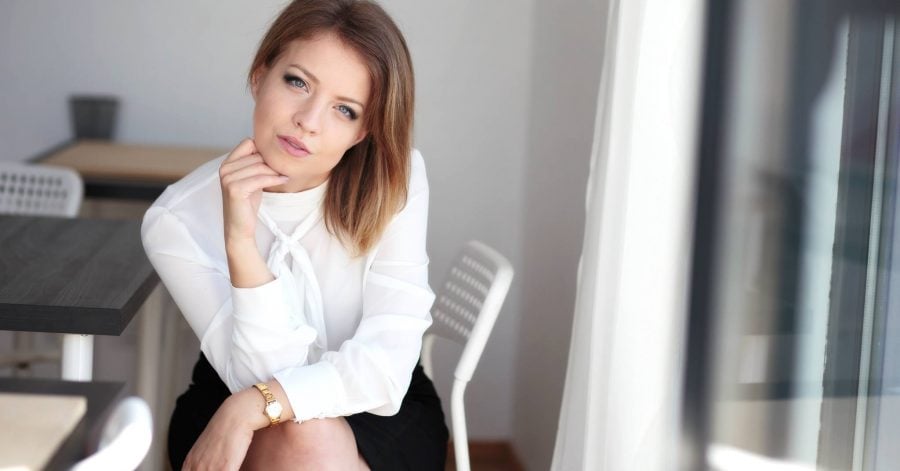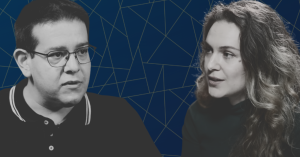As they attempt to make sense of the new digital technologies available, surpass the inevitable challenges of a forced transition to new methods of teaching, and attend to the needs of young generations, teachers are traversing an extraordinary period of transformation – both outside and inside. Few people have a role as important as that of teachers during our youth. How well teachers will handle this transition and adapt to the modern requirements of the future education systems, will influence entire generations.
The Recursive talked to Raluca Bacinschi-Stratulat, co-founder and CEO of iziBac, who also wears the hats of a mentor for startup founders and teacher for high school students.
An architect by training, Raluca started on this journey during college years, initially by helping her colleagues through tutoring. After discovering this passion, she continued to share knowledge and guide young minds by helping high school students in their final years with preparation for the architecture admission exam.
For Raluca, teaching turned out to be another designing and building tool, yet with a more complex subject: the student. iziBac, an app that helps students prepare for the Baccalaureate through gaming, is a testimony of her passion for reaching as many students as possible and in a way that suits their learning styles and unique abilities.
The Recursive: You are an architect, a mentor, a teacher, and a founder. What are the common traits and passions that underlie these different hats you put on?
Raluca Bacinschi-Stratulat: People enjoy drawing, and a lot of people enjoy looking at buildings. But it’s a big difference between drawing and looking at buildings, and actually building them to improve the lives of the people around you.
What is common throughout all of my chosen vocations or career paths, is the fact that I want to improve the lives of the humans around me, whether it’s by using the tool called architecture, or the tool called education. I enjoy building houses and buildings for people, and at the same time, building people. So, the teacher builds the human part, and the architect the non-human part, but I enjoy building a better society overall.
And of course, as an entrepreneur, I want to improve the educational system and the experience of education.
How has the role of the teacher evolved in the past 5 years to the present moment? What were the key drivers?
I’ve been a teacher for the past nine years, also in the public sector. I wanted to see what it means to be a teacher of the current educational system and try to improve it from the inside.
The biggest change I’ve seen with teachers is that we are moving from a provider of information towards a mentor and a guide. Because today the main provider of information is the internet. So, we do not have to be Wikipedia with legs, we can guide, we have this responsibility of guiding the younger souls towards a better direction of using the information to better suit the society. We can solve the hard problems of society. I think that is the biggest change that has happened, mostly because of technological development.
From inside the system, I noticed a more sustainable embracement of technology. Two or three years ago, we were not using technology in a sustainable way. For instance, we started using the virtual catalog, but we were still also putting the grades in a physical catalog. Teachers had to double their efforts in this transition. After a long time and a lot of pressure from edtech startups, this week we managed to accept the virtual catalog.
We need to embrace technology and accept it as a facilitator and not as an amplifier of the effort. So, I think that this will help teachers to focus more on the process of teaching and less on all of the bureaucracy behind it. They can focus on finding alternative ways of teaching, rather than completing the traditional lesson plan on a standard A4 paper. A lot of things are getting systemized and technology is finally becoming a helper.
Of course, the pandemic also pushed us to accelerate the process, by at least 10 years. Many teachers would not have chosen technology as a helper in their educational process. But now they are starting to realize the advantages.
I love how you use Michelangelo’s sculpture to explain how students should be taught today – by being seen and carefully brought to light, instead of being shaped after a certain model. What are the mindset, skillset, and tools of this future teacher-sculptor?
I really enjoy sculpting, not physically, but with my students. The future teacher mindset should be mostly focused on identifying the qualities of students and helping them to improve and to shine. Because each and every single person has some awesome abilities, yet many of us live without realizing them. Instead, we tend to focus on the standard qualities society demands. The mindset and role of the teacher should be to better identify them.
At the same time, teachers need to help pupils and students cultivate patience to work on identifying and developing their personal qualities. Teachers should provide an example by working with themselves. The first way we learn is through mimicry and we continue to do that throughout our lives. I believe teachers should be continuously open minded towards their own qualities, let their “freak flag” fly, and show an example of patience in working on them.
Also, if they do not find the teaching process fun, they won’t be able to make the learning process fun for their students. I enjoy teaching so much because it helps me go into the flow. This is why I also enjoy architecture and entrepreneurship. I think that teachers should spend more time discovering how to reach their own state of flow. The teacher is then the guiding light for students through the state of flow. You need to be there for your pupils to help them decide which path suits them best.
What resources do the teachers of the future need from their environment, as well as from within, to be able to fit this role?
Technology, the government and the private sector help and catalyze the whole process, but I think the biggest resource comes from within. As teachers, we need to ask ourselves: why are we doing this act of teaching? Why do we feel the need to teach? And why do we feel the need to learn? I think the answers lie within spirituality.
Spirituality is something we need to learn how to access as a society, but mostly as teachers, because we are the guides and the pioneers. There are so many instruments we can use, such as meditation, yoga, and prayer. Each and every single religion has its own ways of helping people connect with their authentic selves.
I’m working with every generation, and I see that younger and younger people are more preoccupied with spirituality, with understanding the meaning of existence. They are seekers. So, I think that as teachers, we should provide some guidance because the spiritual journey is full of obstacles.

What can keep the future teacher in Romania, where the educational system presents numerous challenges, instead of finding better opportunities elsewhere?
I was also tempted to leave the country. While I was in college, I would count the number of days until I would finish college, so that I could pack the bags and leave. But graduation day came, and I didn’t, because my mindset had changed.
I’ll explain it with a metaphor. Let’s say you’re a bread maker, and you really enjoy making the bread for your family and friends and for yourself. You start thinking of selling that particular bread to others, too. Where would you go? To a village that already has an amazing bread maker and where you could learn new things? Or to a village that has no bread makers, it’s struggling, and would really enjoy some good bread?
Both choices are fine, because either way, you will do better things. It’s alright to leave the country for new opportunities. You are going to teach people and help them better themselves, while also bettering yourself. We don’t have to keep everyone here to teach Romanians. Teachers need to be fluid and go to whatever village they feel will appreciate their bread. So, instead of focusing on keeping them here, we should focus on presenting the situation more clearly for them.
For me, it was clear that I wanted to feed a village that had no bread maker and I really enjoyed it. I want to learn to bake bread alongside the village. However, I’m happy if we just increase the number of real bread makers, regardless of whether they choose to go.
How do you expect this past one year and a half of disrupted learning experience to influence the education and career paths of students?
It depends a lot on what age group they were during this particular period. Some age groups require physical and personal interaction, like kindergarten and the first years of school. It’s really crucial for children to get to meet each other and to interact with each other and the teacher, in order to define the world around them. At these ages, we define happiness and sadness, failure and success – and we need a lot of examples around us. For smaller children, nonverbal communication is also crucial, especially through facial expressions. I believe the lack of these opportunities will leave a mark. They will have some difficulties with the definitions of things and at the same time with their identity.
But I’m sure that this year can be bypassed. And I know that they can adapt, and they can actually take advantage of these obstacles. What I’ve seen from the whole society during the pandemic is that we’re all starting to ask ourselves “why” in so many areas of our lives. We are also interacting with nature more frequently. We are more connected to our families. And I think they can use these tools to turn this difficult period around.
The biggest issue they have faced was lacking the entourage, the environment where they would be inspired to develop themselves. Because families are great for so many things, but are not great at helping us get out of our comfort zone. More and more of my students have built a solid wall around their comfort zones. Naturally, they felt the need for stability and protection.
Now, it’s going to be hard to embrace other people’s walls, to work as a community. Everyone, not just students, got used to working more as individuals and less as a group. So, the bigger challenges for us as a society will be to rebuild communities and to help each other get out of the comfort zone.
As we focus on rebuilding these communities, what role will technology play?
The role that technology should have played all along. I think technology is increasingly taking its rightful place as a helper for teachers, parents and children. It can be a good catalyzer for these communities and for helping pupils go out of their comfort zones. If used well, technology can help you feel safe, while also challenging you. I see it as a great tool for being in both worlds, without wasting time in traffic, spending a lot of money, effort and energy.
If teachers are going to continue to embrace technology, they need to use it as more than a channel of communication. It’s more than a channel – it could be actually a friend, a helper, a tool to support the educational process. And I know the struggle. Ironically, even though I have an edtech company, it was difficult for me to treat technology as more than a channel at first. But after two weeks, I started using it as a tool. And it really changed the whole experience. Pupils started to see the advantages of the online environment.
I recently started teaching again – some days I teach online, some offline, and some combined. I’ve realized that online teaching can provide a lot of advantages, even for drawing classes. How can you teach drawing through a computer? Many parents have asked, with a lot of disbelief. But after telling them the advantages and showing them a demo, they got onboard. And so did the students.
What would be your number one advice from the heart for the future teacher?
It’s good that you have chosen the heart, because my advice goes from my heart towards theirs. And of course, our hearts are not always open, because we need to keep them in the comfort zone, to reconnect, and so on. But you need to prioritize when it’s the time to open your heart and when it’s the time to go inwards and provide love for your own heart.
Teachers tend to give a lot more than they receive. So, I encourage them to open their hearts and to receive the energy that their children are providing. Children give a lot of energy and we tend to block it, because it’s fuzzy, it has a lot of things that we don’t really want to deal with, and it needs to be filtered. Build your filter and let the energy of the children pass through it and fill your heart because that’s how you’re going to be able to give a lot more.
That’s how I felt the need to start iziBac. I managed to open my heart, and let all the energy of my pupils go inside. I had so much that I needed to give to even more children. And I thought that technology is going to help me reach more children. This is a huge role that technology can play in education: helping us reach children everywhere.








